Zelin Li
Sublinear-Time Algorithms for Diagonally Dominant Systems and Applications to the Friedkin-Johnsen Model
Sep 16, 2025Abstract:We study sublinear-time algorithms for solving linear systems $Sz = b$, where $S$ is a diagonally dominant matrix, i.e., $|S_{ii}| \geq \delta + \sum_{j \ne i} |S_{ij}|$ for all $i \in [n]$, for some $\delta \geq 0$. We present randomized algorithms that, for any $u \in [n]$, return an estimate $z_u$ of $z^*_u$ with additive error $\varepsilon$ or $\varepsilon \lVert z^*\rVert_\infty$, where $z^*$ is some solution to $Sz^* = b$, and the algorithm only needs to read a small portion of the input $S$ and $b$. For example, when the additive error is $\varepsilon$ and assuming $\delta>0$, we give an algorithm that runs in time $O\left( \frac{\|b\|_\infty^2 S_{\max}}{\delta^3 \varepsilon^2} \log \frac{\| b \|_\infty}{\delta \varepsilon} \right)$, where $S_{\max} = \max_{i \in [n]} |S_{ii}|$. We also prove a matching lower bound, showing that the linear dependence on $S_{\max}$ is optimal. Unlike previous sublinear-time algorithms, which apply only to symmetric diagonally dominant matrices with non-negative diagonal entries, our algorithm works for general strictly diagonally dominant matrices ($\delta > 0$) and a broader class of non-strictly diagonally dominant matrices $(\delta = 0)$. Our approach is based on analyzing a simple probabilistic recurrence satisfied by the solution. As an application, we obtain an improved sublinear-time algorithm for opinion estimation in the Friedkin--Johnsen model.
MiniMax-M1: Scaling Test-Time Compute Efficiently with Lightning Attention
Jun 16, 2025Abstract:We introduce MiniMax-M1, the world's first open-weight, large-scale hybrid-attention reasoning model. MiniMax-M1 is powered by a hybrid Mixture-of-Experts (MoE) architecture combined with a lightning attention mechanism. The model is developed based on our previous MiniMax-Text-01 model, which contains a total of 456 billion parameters with 45.9 billion parameters activated per token. The M1 model natively supports a context length of 1 million tokens, 8x the context size of DeepSeek R1. Furthermore, the lightning attention mechanism in MiniMax-M1 enables efficient scaling of test-time compute. These properties make M1 particularly suitable for complex tasks that require processing long inputs and thinking extensively. MiniMax-M1 is trained using large-scale reinforcement learning (RL) on diverse problems including sandbox-based, real-world software engineering environments. In addition to M1's inherent efficiency advantage for RL training, we propose CISPO, a novel RL algorithm to further enhance RL efficiency. CISPO clips importance sampling weights rather than token updates, outperforming other competitive RL variants. Combining hybrid-attention and CISPO enables MiniMax-M1's full RL training on 512 H800 GPUs to complete in only three weeks, with a rental cost of just $534,700. We release two versions of MiniMax-M1 models with 40K and 80K thinking budgets respectively, where the 40K model represents an intermediate phase of the 80K training. Experiments on standard benchmarks show that our models are comparable or superior to strong open-weight models such as the original DeepSeek-R1 and Qwen3-235B, with particular strengths in complex software engineering, tool utilization, and long-context tasks. We publicly release MiniMax-M1 at https://github.com/MiniMax-AI/MiniMax-M1.
LLMEval-Med: A Real-world Clinical Benchmark for Medical LLMs with Physician Validation
Jun 04, 2025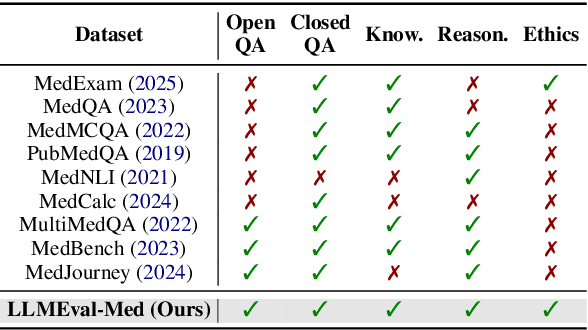
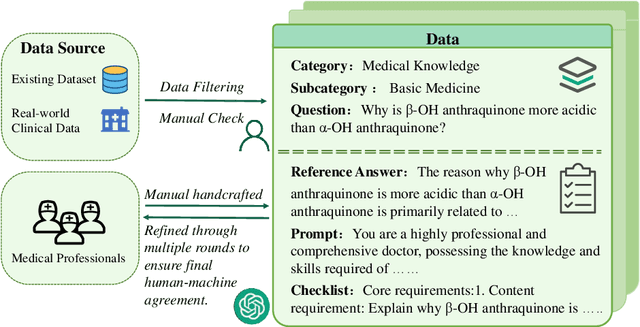

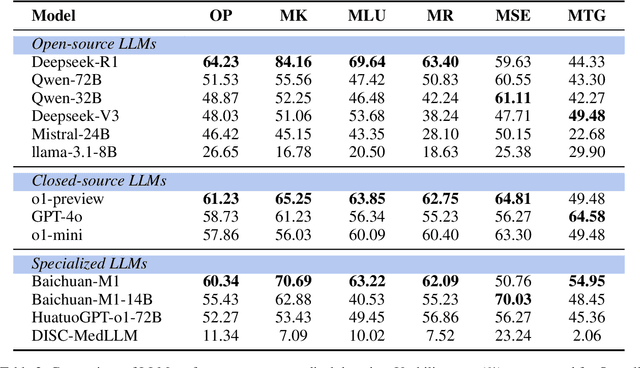
Abstract:Evaluating large language models (LLMs) in medicine is crucial because medical applications require high accuracy with little room for error. Current medical benchmarks have three main types: medical exam-based, comprehensive medical, and specialized assessments. However, these benchmarks have limitations in question design (mostly multiple-choice), data sources (often not derived from real clinical scenarios), and evaluation methods (poor assessment of complex reasoning). To address these issues, we present LLMEval-Med, a new benchmark covering five core medical areas, including 2,996 questions created from real-world electronic health records and expert-designed clinical scenarios. We also design an automated evaluation pipeline, incorporating expert-developed checklists into our LLM-as-Judge framework. Furthermore, our methodology validates machine scoring through human-machine agreement analysis, dynamically refining checklists and prompts based on expert feedback to ensure reliability. We evaluate 13 LLMs across three categories (specialized medical models, open-source models, and closed-source models) on LLMEval-Med, providing valuable insights for the safe and effective deployment of LLMs in medical domains. The dataset is released in https://github.com/llmeval/LLMEval-Med.
Component-Based Fairness in Face Attribute Classification with Bayesian Network-informed Meta Learning
May 03, 2025Abstract:The widespread integration of face recognition technologies into various applications (e.g., access control and personalized advertising) necessitates a critical emphasis on fairness. While previous efforts have focused on demographic fairness, the fairness of individual biological face components remains unexplored. In this paper, we focus on face component fairness, a fairness notion defined by biological face features. To our best knowledge, our work is the first work to mitigate bias of face attribute prediction at the biological feature level. In this work, we identify two key challenges in optimizing face component fairness: attribute label scarcity and attribute inter-dependencies, both of which limit the effectiveness of bias mitigation from previous approaches. To address these issues, we propose \textbf{B}ayesian \textbf{N}etwork-informed \textbf{M}eta \textbf{R}eweighting (BNMR), which incorporates a Bayesian Network calibrator to guide an adaptive meta-learning-based sample reweighting process. During the training process of our approach, the Bayesian Network calibrator dynamically tracks model bias and encodes prior probabilities for face component attributes to overcome the above challenges. To demonstrate the efficacy of our approach, we conduct extensive experiments on a large-scale real-world human face dataset. Our results show that BNMR is able to consistently outperform recent face bias mitigation baselines. Moreover, our results suggest a positive impact of face component fairness on the commonly considered demographic fairness (e.g., \textit{gender}). Our findings pave the way for new research avenues on face component fairness, suggesting that face component fairness could serve as a potential surrogate objective for demographic fairness. The code for our work is publicly available~\footnote{https://github.com/yliuaa/BNMR-FairCompFace.git}.
Volume Tells: Dual Cycle-Consistent Diffusion for 3D Fluorescence Microscopy De-noising and Super-Resolution
Mar 04, 2025Abstract:3D fluorescence microscopy is essential for understanding fundamental life processes through long-term live-cell imaging. However, due to inherent issues in imaging principles, it faces significant challenges including spatially varying noise and anisotropic resolution, where the axial resolution lags behind the lateral resolution up to 4.5 times. Meanwhile, laser power is kept low to maintain cell viability, leading to inaccessible low-noise and high-resolution paired ground truth (GT). To tackle these limitations, a dual Cycle-consistent Diffusion is proposed to effectively mine intra-volume imaging priors within 3D cell volumes in an unsupervised manner, i.e., Volume Tells (VTCD), achieving de-noising and super-resolution (SR) simultaneously. Specifically, a spatially iso-distributed denoiser is designed to exploit the noise distribution consistency between adjacent low-noise and high-noise regions within the 3D cell volume, suppressing the spatially varying noise. Then, in light of the structural consistency of the cell volume, a cross-plane global-propagation SR module propagates high-resolution details from the XY plane into adjacent regions in the XZ and YZ planes, progressively enhancing resolution across the entire 3D cell volume. Experimental results on 10 in vivo cellular dataset demonstrate high improvements in both denoising and super-resolution, with axial resolution enhanced from ~ 430 nm to ~ 90 nm.
TF-Attack: Transferable and Fast Adversarial Attacks on Large Language Models
Aug 26, 2024Abstract:With the great advancements in large language models (LLMs), adversarial attacks against LLMs have recently attracted increasing attention. We found that pre-existing adversarial attack methodologies exhibit limited transferability and are notably inefficient, particularly when applied to LLMs. In this paper, we analyze the core mechanisms of previous predominant adversarial attack methods, revealing that 1) the distributions of importance score differ markedly among victim models, restricting the transferability; 2) the sequential attack processes induces substantial time overheads. Based on the above two insights, we introduce a new scheme, named TF-Attack, for Transferable and Fast adversarial attacks on LLMs. TF-Attack employs an external LLM as a third-party overseer rather than the victim model to identify critical units within sentences. Moreover, TF-Attack introduces the concept of Importance Level, which allows for parallel substitutions of attacks. We conduct extensive experiments on 6 widely adopted benchmarks, evaluating the proposed method through both automatic and human metrics. Results show that our method consistently surpasses previous methods in transferability and delivers significant speed improvements, up to 20 times faster than earlier attack strategies.
Self-Supervised Learning for Building Damage Assessment from Large-scale xBD Satellite Imagery Benchmark Datasets
Jun 01, 2022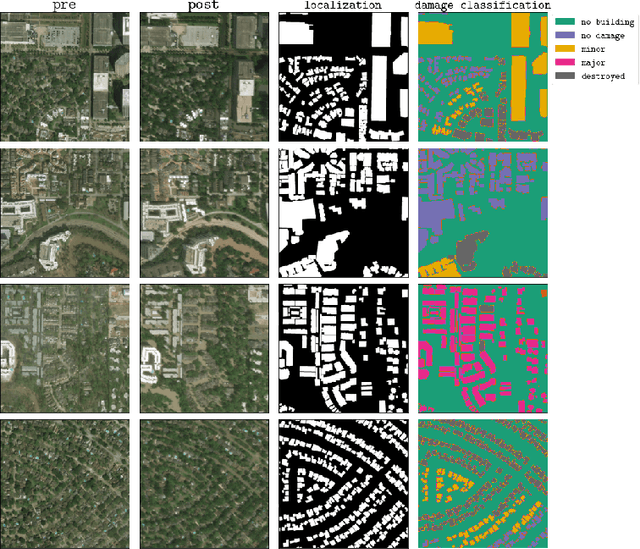
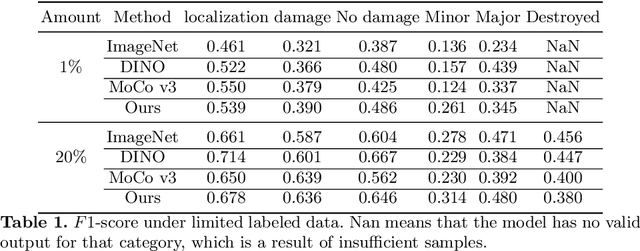
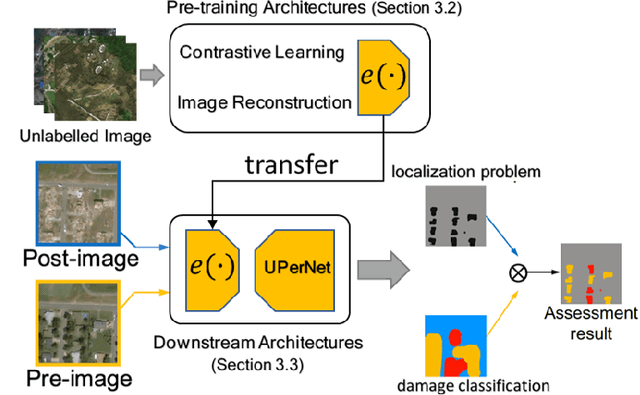
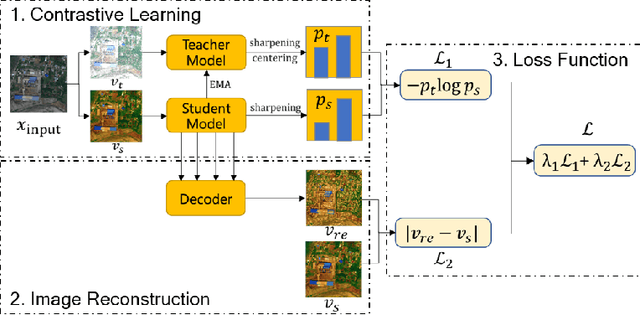
Abstract:In the field of post-disaster assessment, for timely and accurate rescue and localization after a disaster, people need to know the location of damaged buildings. In deep learning, some scholars have proposed methods to make automatic and highly accurate building damage assessments by remote sensing images, which are proved to be more efficient than assessment by domain experts. However, due to the lack of a large amount of labeled data, these kinds of tasks can suffer from being able to do an accurate assessment, as the efficiency of deep learning models relies highly on labeled data. Although existing semi-supervised and unsupervised studies have made breakthroughs in this area, none of them has completely solved this problem. Therefore, we propose adopting a self-supervised comparative learning approach to address the task without the requirement of labeled data. We constructed a novel asymmetric twin network architecture and tested its performance on the xBD dataset. Experiment results of our model show the improvement compared to baseline and commonly used methods. We also demonstrated the potential of self-supervised methods for building damage recognition awareness.
Source Free Unsupervised Graph Domain Adaptation
Dec 03, 2021



Abstract:Graph Neural Networks (GNNs) have achieved great success on a variety of tasks with graph-structural data, among which node classification is an essential one. Unsupervised Graph Domain Adaptation (UGDA) shows its practical value of reducing the labeling cost for node classification. It leverages knowledge from a labeled graph (i.e., source domain) to tackle the same task on another unlabeled graph (i.e., target domain). Most existing UGDA methods heavily rely on the labeled graph in the source domain. They utilize labels from the source domain as the supervision signal and are jointly trained on both the source graph and the target graph. However, in some real-world scenarios, the source graph is inaccessible because of either unavailability or privacy issues. Therefore, we propose a novel scenario named Source Free Unsupervised Graph Domain Adaptation (SFUGDA). In this scenario, the only information we can leverage from the source domain is the well-trained source model, without any exposure to the source graph and its labels. As a result, existing UGDA methods are not feasible anymore. To address the non-trivial adaptation challenges in this practical scenario, we propose a model-agnostic algorithm for domain adaptation to fully exploit the discriminative ability of the source model while preserving the consistency of structural proximity on the target graph. We prove the effectiveness of the proposed algorithm both theoretically and empirically. The experimental results on four cross-domain tasks show consistent improvements of the Macro-F1 score up to 0.17.
 Add to Chrome
Add to Chrome Add to Firefox
Add to Firefox Add to Edge
Add to Edge